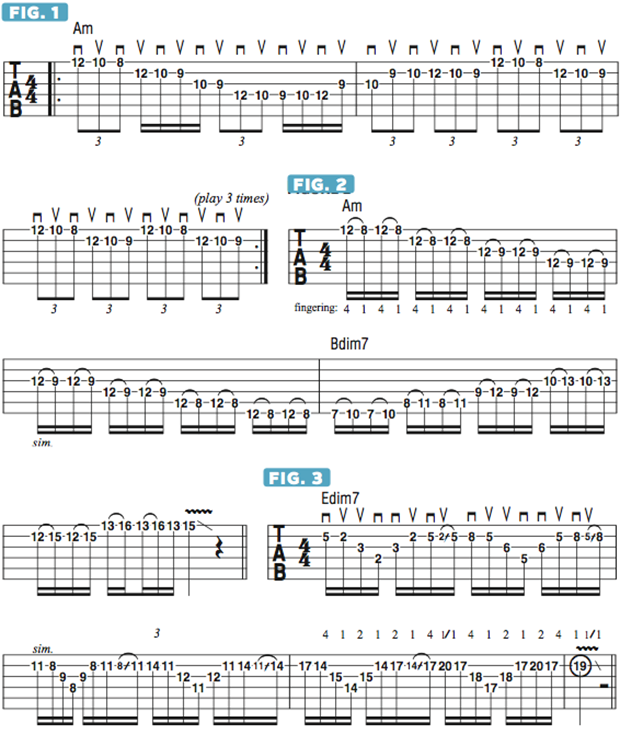A Fresh Batch of Technically Challenging Exercises to Keep Your Chops Fired Up
Some fresh guitar playing exercises/calisthenics that you can use to quickly and efficiently get your pick- and fret-hand chops back in shape.
Way back in the Holiday 2012 issue, I compared guitar playing to being like a winter sport.
In the summer, we tend to put away our guitars while we engage in outdoor summer activities.
Speaking for myself, my chops tend to get a little neglected over the warm months, whereas in the winter, I’m happy to sit by the fire and play guitar for hours on end. As we head into the dead of winter, I'd like to revisit this topic and provide some fresh guitar playing exercises/calisthenics that you can use to quickly and efficiently get your pick- and fret-hand chops back in shape.
FIGURE 1 is a single-note run based on the A harmonic minor scale (A B C D E F G#), which is intervallically spelled 1 2 b3 4 5 b6 7. Using alternate picking and a three-notes-per-string approach throughout (except on the third string where two notes are played), I start with a downstroke, descending from a high E note (first string, 12th fret) down one and a half octaves to B (fourth string, ninth fret), and then back up the scale to a B note one octave higher. I then alternate between repeated descending eighth-note triplets on the B and high E strings, after which I return to the beginning of the lick and repeat the note sequence from the top.
As you’ll notice, the rhythmic phrasing of this run is a little odd in bar 1 in that I switch from eighth-note triplets to 16th notes twice; bars 2 and 3 consist of eighth-note triplets only. Count slowly and carefully as you become accustomed to the phrase, and be sure to keep the alternate picking consistent.
As always, start slowly and gradually build speed. Strive to play as cleanly and efficiently as possible while remaining relaxed and not expending effort/energy unnecessarily. Hammer-ons and pull-offs are essential elements of fret-hand technique, and FIGURE 2 is designed to work specifically on them.
You begin with a long series of repeated pull-offs that descend from high to low strings and then begin a series of ascending hammer-ons that bring you back up from the low E string to the high E. In bars 1 and 2, I repeatedly play pairs of two-note pull-offs on each string, fretting all notes with the index finger and pinkie. I think of this first two-bar phrase as an Am-type run. In bars 3 and 4, I ascend using index-to-pinkie hammer-ons, moving up from low to high strings within the structure of B diminished seven (B D F G#). I conclude the phrase on a high G note with vibrato.
FIGURE 3 offers another diminished exercise, this one being more of a sweep-arpeggio type of idea, in that one must quickly descend and ascend across the G and D strings with only one note played on each string. I think of this as E diminished seven (E G Bb C#), but any of the notes may be thought of as the root (this is true of all diminished-seven arpeggios). I use a combination of alternate and economy picking to play this exercise and quick index-finger slides up the B string every two beats to shift up to the next higher symmetrical arpeggio inversion.

Get The Pick Newsletter
All the latest guitar news, interviews, lessons, reviews, deals and more, direct to your inbox!
“There are so many sounds to be discovered when you get away from using a pick”: Jared James Nichols shows you how to add “snap, crackle and pop” to your playing with banjo rolls and string snaps
Don't let chord inversions bamboozle you. It's simply the case of shuffling the notes around







![Joe Bonamassa [left] wears a deep blue suit and polka-dotted shirt and plays his green refin Strat; the late Irish blues legend Rory Gallagher [right] screams and inflicts some punishment on his heavily worn number one Stratocaster.](https://cdn.mos.cms.futurecdn.net/cw28h7UBcTVfTLs7p7eiLe.jpg)


